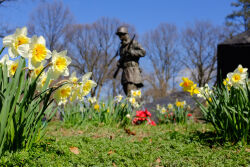Kissena Park
Kissena Park
What was here before?
Throughout most of the 18th and 19th centuries, Flushing enjoyed the reputation as America's premiere horticultural center. In 1735, William Prince established the first commercial nursery in the Americas in northern Flushing. Famous patrons of the area’s plants and trees included England's future King William IV, George Washington, and explorers Meriwether Lewis and William Clark, who left behind specimens from their expeditions.
By the early 1870s, horticulturist Samuel Bowne Parsons (1819-1906) established a nursery at the site now home to the historic tree grove. Parsons’ nursery imported over 100 varieties of exotic trees and was the first nursery to introduce Japanese maples and propagate rhododendron. Famous landscape architect Frederick Law Olmsted (1822-1903) purchased and used many of Parson's trees for the construction of Central Park and Brooklyn’s Prospect Park.
How did this site become a park?
In 1904, the City purchased Kissena Lake from William T. Janes, whose father-in-law had run an ice cutting and manufacturing company on the lake in the late 19th century. Following Parsons’ death in 1906, the city acquired his historic tree grove, and a year later 65 acres of what was then mostly swampland were purchased. In 1914 the city bought a training farm for the Police Department’s horses. Condemnation procedures and private purchases added to the park through 1927, and in 1947 Kissena Park became part of the “Queens Corridor” park system through the addition of Kissena Corridor Park, which links Kissena Park with Flushing Meadows-Corona Park and Cunningham Park.
In 1942, Kissena Lake was drained and transformed into a “bathtub lake,” with a concrete bottom and shoreline. The lake was drained again in 1983 due to a buildup of algae. In 2003, the lake was restored to a more natural appearance using a new aeration system to prevent the growth of algae and utilizing well water to replace city water.
The Kissena Velodrome was completed in 1963. It was showcased during the 1964 World’s Fair, and that same year it hosted the U.S. Olympic Team Trials. The Siegfried Stern Kissena Park Bicycle Track was named for Siegfried Stern, treasurer for Hartz Mountain Products and benefactor of many Jewish organizations. After a reconstruction, the Kissena Velodrome reopened in 2004 as a state-of-the-art cycling facility.
First planted in 1986, the Charlie Emerson Wildlife Garden and adjacent nature center were dedicated to the memory the Queens naturalist in 1990. The tree grove that was once part of Parsons’ nursery now includes more than 100 different types of trees. In 2018, a new public restroom was constructed. As of 2022, added green infrastructure now helps capture storm water in the park.
Near the park’s entrance at Rose Avenue and Parsons Boulevard, the Korean War Memorial stands in honor of the Queens men and women who fought to defend South Korea between 1950 and 1953. Completed in 2007 and designed by William Crozier (b. 1942), the main sculpture is titled The Anguish of Experience, and features a solitary soldier whose face portrays the agony of war. On a smaller scale behind him are the silhouettes of five soldiers carrying a stretcher and scaling the dangerous mountain terrain of Korea.
Today, community groups such as the Kissena Park Civic Association and Friends of Kissena Park take active roles initiating park clean-ups, planting gardens, and installing litter basins.
What is this park named for?
The park was named in 1908 after Kissena Lake. It is thought that Parsons, a horticulturist and amateur student of Native American lore, named the lake in the mid-19th century after the Chippewa word “kissina,” meaning “it is cold.”
Check out your park's Vital Signs
Clean & Safe
Green & Resilient
Empowered & Engaged Users
Share your feedback or learn more about how this park is part of a
Vital Park System
Contacts
District Maintenance & Operations Office: (718) 359-1297










